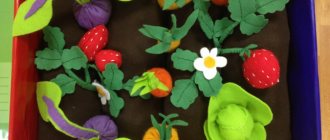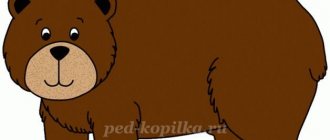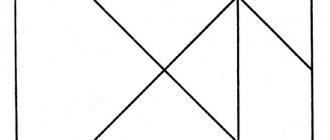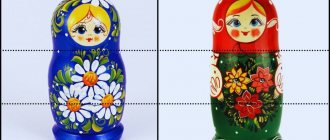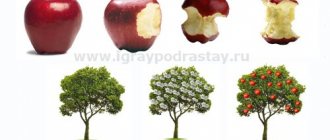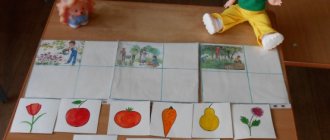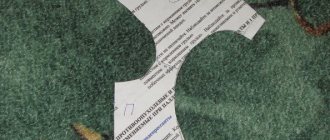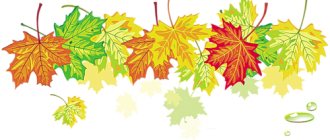GAME – “ONE IS MANY”
GAME – “WORDS REVERSE”
Instructions:
“Let’s play a game using a ball. I will say the word and throw you the ball. You catch it, say the word backwards and throw the ball back to me. It's clear? Let's try…"
Antonyms – nouns
| First time set | Set for the second time (fastening) |
| night - day friend - enemy winter - summer mom - dad dirt - cleanliness heat - cold good - evil benefit - harm brother - sister joy - sadness, sadness floor - ceiling cat - dog earth - sky west - east leaf - notebook / paint album – pencils light – dark circle – square fire – water plant – animal silence – sound | north - south rich man - poor man noise - silence warm - cool clear - cloudy pencil - pen ball - cube table - chair grandfather - grandmother skirt - trousers leg - hand water - ice/snow spoon - fork morning - evening adult - child stone - sand puddle – sea/ocean sour – sweet tears – smile peace – war, quarrel autumn – spring |
Burdina S.V. Preschooler's folder. Kirov, 2005
GAME – “WORDS REVERSE”
Instructions:
“Let’s play a game using a ball. I will say the word and throw you the ball. You catch it, say the word backwards and throw the ball back to me. It's clear? Let's try…"
Antonyms – adjectives
| First time set | Set for the second time (fastening) |
| strong - weak rich - poor left - right sick - healthy clean - dirty deep - shallow bitter - sweet brave - cowardly loud - quiet young - old close - distant high - low straight - crooked soft - hard heavy - light fast - slow cheerful - sad hot – cold dark – light big – small | thick - thin black - white good - evil crooked - straight straight - crooked prickly - fluffy white - black round - square cloudy - clear loud - quiet new - old pleasant - nasty wet - dry southern - northern sharp - stupid neat - careless joyful - sad peaceful – hostile empty – full thin – fat |
Burdina S.V. Preschooler's folder. Kirov, 2005
GAME – “WORDS REVERSE”
Instructions:
“Let’s play a game using a ball. I will say the word and throw you the ball. You catch it, say the word backwards and throw the ball back to me. It's clear? Let's try…"
Antonyms - verbs
| First time set | Set for the second time (fastening) |
| extinguish - light warm - cool help - interfere lie down - get up laugh - cry move away - approach speak - remain silent do - be lazy / idle freeze - warm up fall asleep - wake up bury - dig up dirty - clean, wipe wet - dry speak - be silent cover - clean spread – cover put on shoes – take off shoes put on – undress get dressed – undress build – demolish | bring - take away collect - disassemble glue - peel off boil - cool screw in / twist - unscrew climb in - get out / get off sit - stand up write / draw - erase work - rest eat - drink eat / eat - fast slow down - hurry walk - run fly - swim /go sick - get well break - do turn around - turn away read - write / listen set fire - extinguish |
Burdina S.V. Preschooler's folder. Kirov, 2005
GAME – “ONE IS MANY”
Instructions:
“Let’s play a game using a ball. I will say the word and throw you the ball. You catch it, say the word in the plural (when there is a lot) and throw the ball back to me. It's clear? Let's try…"
| First time set | Set for the second time (fastening) |
| One ball, and five... (balls) One flower, and many... (flowers) One spoon, and seven... (spoons) One button, and ten... (buttons) One ear, and two... (ears), but many... ( ears) One mirror, and seven... (mirrors) One cookie, and many (cookies) One goose, and three... (geese) One trousers, and many... (trousers) One tree, and six... (trees) One shoulder, and many... (shoulders) One is a baby squirrel, and four are... (baby squirrels) One is in about ron, and many... (in about rons) One is a thief , and four are (thieves ) One is forehead, and seven... (foreheads) One cafe and many...(cafe) One child, and many...(children) One lesson, and nine (activities) One car, and eight (cars) One hand, and many...(hands) | One spoon, but many...(spoons) One drop, and seven... (drops) One cow, and eight...(cows) One chair, and five...(chairs) One glass, and ten (glasses) One sock, but many... (socks) One kitten, and five... (kittens). One candle, and many...(candles) One birch, and three... (birches) One cedar, and two...(cedars) One window, and many...(windows) One person, and many (people) One calf, and eight ( calves) One eye, and two ... (eyes), but many ... (eyes) One chair, and seven ... (chairs) One Moon, and many ... (Moons) One earth, and many ... (earths) One Earth, but many ...(Lands) One house, and many...(houses) One transformer, and two...(transformers) One doll, and three... (dolls) |
Burdina S.V. Preschooler's folder. Kirov, 2005
Didactic game “Decompose into sets” material
Didactic game
"Decompose into sets"
Description of the material: The material is intended for children of the preparatory group, to reinforce the theme “Multiple”.
Goal: continue to introduce children to the concept of “Multiple.”
Software tasks:
- strengthen children’s ability to form sets according to certain characteristics; - develop children’s ability to identify sets with the largest, average and smallest number of elements;
- train children to distribute elements between sets that are in certain relationships with each other (union of sets, intersection of sets, subset - a set that is part of another set);
— to develop study skills;
- develop logical thinking, memory, imagination;
- fostering friendly relationships between children;
Planned result: children’s ability to identify sets, see elements and the relationship between elements of various sets. Equipment and materials:
digital educational resource “World of Informatics”, a set of objects, sheets with tasks for children, colored pencils. Procedure: - Guys, let’s play the game “Decompose into sets”. Come to me. There are objects on the table. Form sets from these objects.
- How many sets did you get? What sets are these? How many elements are in each set?
Children's answers.
- Okay, guys! Now look at these same objects again and try to form other sets.
— What sets did you get? How many elements are in each set? Children's answers.
- Conclusion: From a different set of objects, you can create a different number of sets based on common properties or characteristics. - Guys, sit down at the tables. Let's continue playing. Look at the first assignment sheet. What sets do you see here?
Children's answers.
- Now you must take a red pencil and color in the elements of the set with the largest number of elements. Which set is the largest and why? Children's answers.
— Guys, now you must find a set with an average number of elements and color these elements yellow. What set is this and why? Children's answers.
— Now find the set with the smallest number of elements and color the elements of this set green.
- Well done! Let's move on to the second task on pieces of paper.
Look: the pieces of paper depict objects and 2 intersecting circles. Each circle is a set. Read the names of the sets. Now, with arrows from each item, you must show which item should be placed in which set. Don't forget about the area of intersection of two sets.
— Guys, tell us what kind of sets you got and how many elements each set contains.
Children's answers.
- What did you place in the area of intersection of two sets and why? Children’s answers.
— Guys, you completed the tasks given to you. Let's move on to computer desks now. Tasks are already open on the desktops, where you will have to create sets of the elements offered to you. The elements are located on the right side of the screen, by clicking on the left button of the computer mouse, you must move the objects to the left side of the screen, there will be a circle or several circles symbolizing sets.
— Task 1: make up a set from the corresponding elements, which is the union of two sets - a set of fish and a set of birds.
— How many elements did you get in this set? - In this case, when combining two sets, we got a lot of living beings.
— Task 2: make up a set of living beings, selecting a subset - a set of birds.
— How many elements did you get in the multitude of birds, and how many in the multitude of living beings?
Children's answers.
- Task 3: make up a set of objects made by man, highlighting two subsets - a lot of dishes and a lot of toys.
- How many elements did you get in a variety of dishes, how many in a variety of toys, and how many in a variety of objects made by man?
Children's answers.
— Task 4: make up sets of sea inhabitants and a set of mammals, do not miss the moment that there is an area where these two sets intersect.
— How many elements did you get in the variety of sea inhabitants, and how many in the variety of mammals?
Children's answers.
How many elements did you get in the set of sea inhabitants, and how many in the set of mammals?
Children's answers.
MAGAZINE Preschooler.RF
Passport for the didactic game for speech development “One - Many” for children 5-7 years old with speech development disorderMunicipal state preschool educational institution of the city of Novosibirsk “Kindergarten No. 484 of a combined type” 630112, Novosibirsk, st. Selezneva, 48a, t. 224-02-13
Author-performer Yulia Mikhailovna Zaikova teacher-speech therapist of the first qualification category Novosibirsk, 2020
Title of the manual: didactic game “One - Many” .
Educational areas: cognitive development, speech development.
The need to create a manual: Currently, experts in the field of early child development insist that the development of intellectual and thinking processes must begin with the development of hand movements, and in particular with the development of movements in the fingers. This is due to the fact that the development of the hand plays an important role in the formation of the brain, its cognitive abilities and the development of speech. The development of fine motor skills is also important because the child’s entire future life will require the use of precise, coordinated movements of the hand and fingers, which are necessary to draw and glue, write, dress, and perform many different everyday and educational activities.
So what are fine motor skills?
Fine motor skills are the coordinated actions of the hands and fingers, which are performed in conjunction with the nervous, skeletal, visual and muscular systems. In other words, it is the ability to manipulate small objects using only the small muscles of the body.
Fine motor skills begin to develop from birth: first, the baby examines his hands, then learns to clench and unclench his fingers, control them in order to grab a toy or a nearby object. As he grows up, he understands how to hold a brush or pencil correctly, learns to draw, and closer to 6–7 years old he tries to write.
Lack of development of fine motor skills can lead to consequences for the child such as:
- lack of interest in drawing, modeling and other activities;
- difficulties with adaptation to the educational process at school: the child perceives new material worse, reads poorly, so the pace of learning seems too fast and difficult to him;
- insufficient development of creativity, thinking and attention;
- inability to draw a straight line or remember and write numbers or letters correctly;
- if you ask him to draw a picture, in most cases he cannot correctly place objects on the space of the sheet, he lacks imagination, there is no variety of colors and a clear plot;
- Such children begin to speak later; many have speech defects that are difficult to correct even during classes with specialists.
Poor motor skills of the fingers give poor results when performing various tasks, such as: tracing a figure, drawing according to a model, etc. The child gets tired quickly and his performance decreases. Lack of preparation for writing and insufficient development of fine motor skills can lead to a negative attitude towards learning, both in a normally developing child and in a child with special educational needs (in particular, in children with severe speech impairments).
Children with SLI often experience delays in the development of gross and fine motor skills. The technique of movements and motor qualities (dexterity, speed, accuracy, coordination) are mainly affected, and psychomotor deficiencies are revealed. Self-service skills and technical skills in visual arts are poorly developed.
In a large number of children with SLI, various forms of motor disorders are often revealed during examination. Sometimes even minor dysfunction of the mobile sphere without relevant and targeted corrective influences can lead to secondary underdevelopment of more problematic and differentiated movements and actions, which negatively affects the development of writing, drawing, design and other forms of manual activity of the child. A change (increase or decrease) in muscle tone entails exhaustion and asthenicity of the muscles of the hands. Insufficient differentiation of the innervation of the muscles of the fingers and hands makes movements awkward and prevents their coordination and smoothness. Therefore, the child cannot hold a pencil for a long time; as fatigue increases, his movements become imprecise, large-scale, or too small.
Thus, the development of fine motor skills is one of the most important tasks in teaching a child with SLI. You can develop fine motor skills in different ways: through the use of finger games, games for the development of tactile sensations, exercises for self-massage of the hands using cones, a soft ball, pencils, etc. But I think the most successful way to develop fine motor skills in preschoolers with SLI is playing with clothespins. They arouse the child’s interest and contribute to the development of not only fine motor skills, but also higher mental functions and hand-eye coordination.
The novelty of the game lies in the fact that it has a wide range of possibilities. With the help of this game, you can develop in children such a complex concept as inflection, the nominative function of speech (naming objects), expand your vocabulary, form fine motor skills and higher mental functions.
Purpose of the game: development of the nominative function of speech, formation of the ability to form word forms and lexemes that have different grammatical meanings (inflection by numbers: singular and plural).
Tasks:
- Help expand children's vocabulary.
- Form higher mental functions and hand-eye coordination.
- Develop fine motor skills of the hand.
- Develop the ability to act in accordance with the teacher’s instructions.
- Develop the nominative function of speech.
- To develop the ability to form word forms and lexemes that have different grammatical meanings (inflection by numbers: singular and plural).
Description of the manual:
The game package includes:
- Cards with tasks – 10 pcs.
- Clothespins – 20 pcs.
Progress of the game:
The teacher places a card in front of the child and asks what is shown on it. Asks the child to show one object, many objects and name them. Then he gives a clothespin and offers to pin a picture with one object or several objects.
Recommendations for using the game:
- This didactic game is intended for preschool children with SLD.
- The game “One - Many” can be used both in classes on FCCM, speech development, and in the process of independent activity of children.
- This game promotes the development of the nominative function of speech, enriching children's vocabulary, and the development of inflection.
| Next > |
